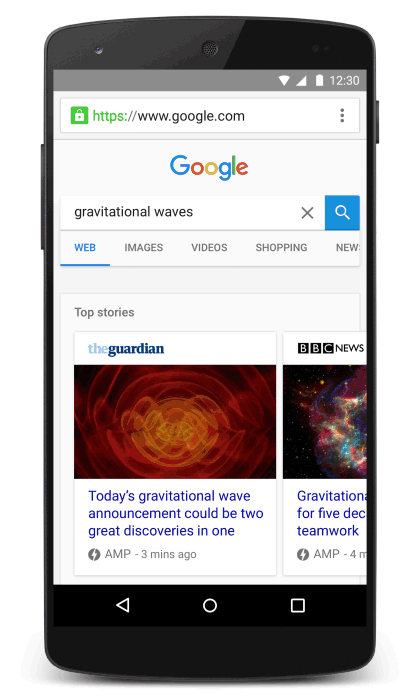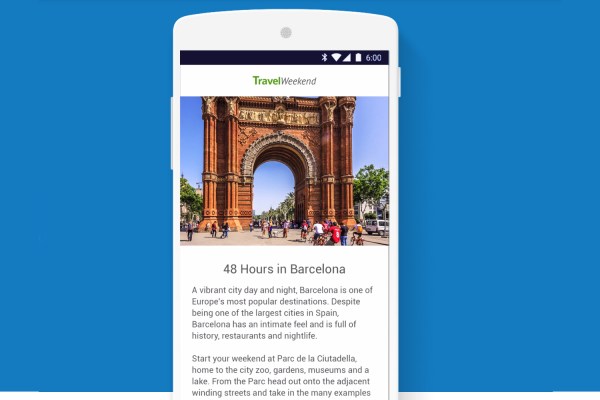Smartphones and networks are constantly getting faster, but somehow the mobile web now feels slower than it ever did. That’s largely thanks to all the ads and trackers that most sites now use (and maybe the abundance of large GIFs, too).
A few months ago, Google set out to change this when it launched the Accelerated Mobile Page (AMP) project that aims to bring a Facebook Instant Article’s like experience to the open web. Starting today, Google will start highlighting AMP-enabled pages in its mobile search results.
 For the most part, this means that when you search for news items (AMP, in its current form, is mostly meant to accelerate news sites), Google will now often show you a carousel that highlights stories on AMP-enabled sites. This carousel is pretty much the same as the one you’ve likely already seen for searches that kick off Google’s Twitter results carousel. The difference here, though, is that when you click on one of these links, the result loads instantly (or with a very minor delay). If you are on a really slow connection, though, AMP pages will take a bit to load — this isn’t magic, after all — but even then, they will still load up significantly faster than regular mobile pages.
For the most part, this means that when you search for news items (AMP, in its current form, is mostly meant to accelerate news sites), Google will now often show you a carousel that highlights stories on AMP-enabled sites. This carousel is pretty much the same as the one you’ve likely already seen for searches that kick off Google’s Twitter results carousel. The difference here, though, is that when you click on one of these links, the result loads instantly (or with a very minor delay). If you are on a really slow connection, though, AMP pages will take a bit to load — this isn’t magic, after all — but even then, they will still load up significantly faster than regular mobile pages.
When you click on a story in the carousel, Google loads the page, but you can also swipe left and right to jump to the other stories in the carousel as well without having to go back to the search results page.
For the most part, you’ll likely encounter AMP through this carousel for now, but Google tells me it will also occasionally show a single AMP page in its search results. Just like in the carousel, these individual sites will be highlighted with a green AMP icon.
A number of publishers have already launched their AMP pages and TechCrunch will also join their ranks soon. In addition, services like WordPress.com now also support AMP.
 Google says AMP pages load four times faster and use ten times less data than non-AMP pages. That’s because these pages are essentially stripped-down HTML pages with some AMP-specific markup. Google pre-renders some of these pages, too, and maybe even more importantly, it has worked with ad networks and analytics firms to improve how they handle AMP pages, too.
Google says AMP pages load four times faster and use ten times less data than non-AMP pages. That’s because these pages are essentially stripped-down HTML pages with some AMP-specific markup. Google pre-renders some of these pages, too, and maybe even more importantly, it has worked with ad networks and analytics firms to improve how they handle AMP pages, too.
Because AMP is an open-source project, publishers can integrate it without too much trouble. No publishers, however, would’ve integrated AMP if their ad networks and analytics services didn’t also support it. Google launched the project with support for ad networks like Outbrain, AOL, OpenX, DoubleClick and AdSense, as well as analytics services like comScore, Adobe Analytics, Parse.ly, Chartbeat, Nielsen, ClickTale and Google Analytics. Instead of firing off analytics to multiple analytics services (most publishers use more than one), AMP creates a single call that is then routed to the different services. That alone speeds up page loading times by quite a bit.
AMP also supports paywalls as well as sponsored content, as well as many video players.
As Google’s product manager for the AMP project Rudy Galfi told me, he believes Google has only scratched the surface with regard to advertising in AMP but he believes support is now “in a really good place.”
As Galfi told me, the team saw over 1,300 code submissions to its GitHub page since the company first announced the project and over 5,800 developers have now contributed.
Google is obviously giving AMP-enabled pages top billing on its search results pages. The company has a clear interest in preserving the open web and the only way to do that is by giving users a better experience than the one they can get in the walled gardens of Facebook and Co. Still, sites that don’t have AMP enabled will now be relegated to a lower ranking, even though Google says AMP is only one of the many ranking signals it uses.
“We still want to make sure we show users the answer to their questions and give them the best experience,” Galfi said — and while that’s true, there can be little doubt that AMP pages provide a far superior experience than standard mobile pages.
